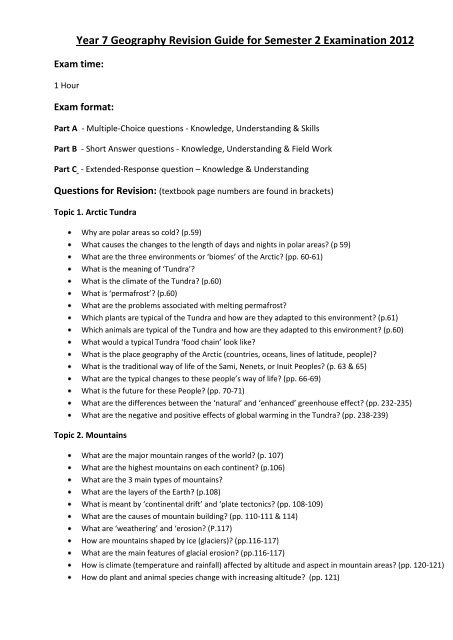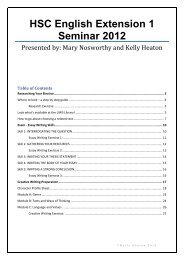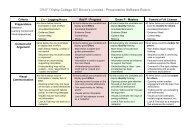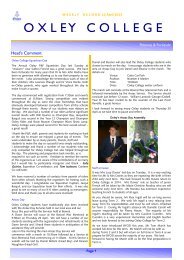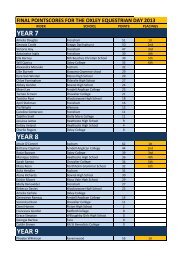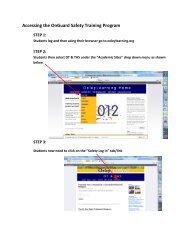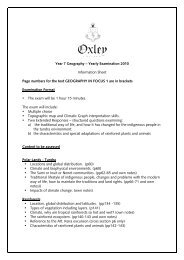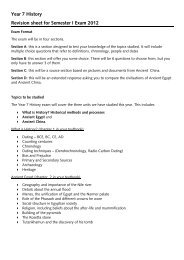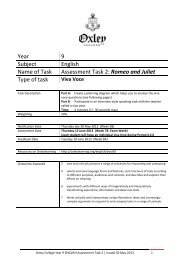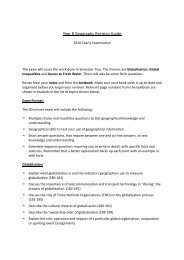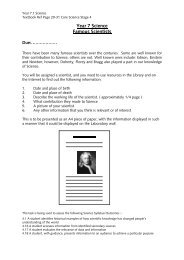7 Geo Revision Guide
7 Geo Revision Guide
7 Geo Revision Guide
Create successful ePaper yourself
Turn your PDF publications into a flip-book with our unique Google optimized e-Paper software.
Year 7 <strong>Geo</strong>graphy <strong>Revision</strong> <strong>Guide</strong> for Semester 2 Examination 2012<br />
Exam time:<br />
1 Hour<br />
Exam format:<br />
Part A - Multiple-Choice questions - Knowledge, Understanding & Skills<br />
Part B - Short Answer questions - Knowledge, Understanding & Field Work<br />
Part C - Extended-Response question – Knowledge & Understanding<br />
Questions for <strong>Revision</strong>: (textbook page numbers are found in brackets)<br />
Topic 1. Arctic Tundra<br />
Why are polar areas so cold? (p.59)<br />
What causes the changes to the length of days and nights in polar areas? (p 59)<br />
What are the three environments or ‘biomes’ of the Arctic? (pp. 60-61)<br />
What is the meaning of ‘Tundra’?<br />
What is the climate of the Tundra? (p.60)<br />
What is ‘permafrost’? (p.60)<br />
What are the problems associated with melting permafrost?<br />
Which plants are typical of the Tundra and how are they adapted to this environment? (p.61)<br />
Which animals are typical of the Tundra and how are they adapted to this environment? (p.60)<br />
What would a typical Tundra ‘food chain’ look like?<br />
What is the place geography of the Arctic (countries, oceans, lines of latitude, people)?<br />
What is the traditional way of life of the Sami, Nenets, or Inuit Peoples? (p. 63 & 65)<br />
What are the typical changes to these people’s way of life? (pp. 66-69)<br />
What is the future for these People? (pp. 70-71)<br />
What are the differences between the ‘natural’ and ‘enhanced’ greenhouse effect? (pp. 232-235)<br />
What are the negative and positive effects of global warming in the Tundra? (pp. 238-239)<br />
Topic 2. Mountains<br />
What are the major mountain ranges of the world? (p. 107)<br />
What are the highest mountains on each continent? (p.106)<br />
What are the 3 main types of mountains?<br />
What are the layers of the Earth? (p.108)<br />
What is meant by ‘continental drift’ and ‘plate tectonics? (pp. 108-109)<br />
What are the causes of mountain building? (pp. 110-111 & 114)<br />
What are ‘weathering’ and ‘erosion? (P.117)<br />
How are mountains shaped by ice (glaciers)? (pp.116-117)<br />
What are the main features of glacial erosion? (pp.116-117)<br />
How is climate (temperature and rainfall) affected by altitude and aspect in mountain areas? (pp. 120-121)<br />
How do plant and animal species change with increasing altitude? (pp. 121)
Skills (including field work):<br />
What is meant by the ‘topography’ of an area?<br />
How are features found on a topographic map using area references and grid references? (p.11)<br />
How is distance measured on a topographic map? (p.10)<br />
What are the directions on a 16-point compass rose? (p.10)<br />
What is a ‘contour’ line? (p. 12 & 118)<br />
How do contour lines show the steepness of the land on a topographic map? (p. 118)<br />
How do contour lines show the shape of the land on a topographic map? (p.118)<br />
How is land use shown on a topographic map? (p.119)<br />
How do you draw a climate graph? (p. 64)<br />
What is meant by ‘average annual rainfall’ and ‘temperature range’? (p. 64)<br />
How do you measure tree cover?<br />
How do you compare soil depth, soil texture and soil moisture in an area of field study?<br />
Equipment:<br />
Blue or black pen<br />
Sharp pencil<br />
Eraser<br />
Ruler<br />
Coloured pencils<br />
Calculator<br />
Good Luck from TD, MI, CR!


